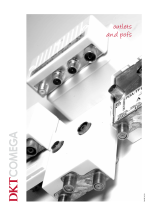Page is loading ...

APPLICATION NOTES:
ODIN with ROAMEO
ODIN is a fully OMNEO-capable 1RU matrix with the ability to work with ROAMEO, a DECT-based wireless
communication system. In this Note we will look at a couple of ways ODIN can support ROAMEO in truck
applications.
In Television production, the term Outside Broadcasting (OB) is used for sports events, music concerts etc not
occurring in a studio. OB-vans contain all the equipment required for producing these events and sending them
back (via satellite) to the network for distribution. Among the many different types of equipment installed in OB-
vans, an intercom system including wireless capability is mandatory. For larger productions, multiple OB-vans
are used, and the ability to interconnect the intercom systems becomes important.
Figure 1 shows a typical way in which Access
Points may be connected to ODIN. ODIN has
two RJ-45 connectors for OMNEO. If the Rapid
Spanning Tree Protocol (RSTP) is enabled, the
Access Points may be connected in a loop,
which makes it resilient to a single cabling fault.
Without RSTP, a loop must not be used. A more
complete discussion of ways of connecting
ROAMEO Access Points may be found in the
App Note titled “ROAMEO Wiring Architecture”.
In the following example we imagine two trucks, each with its own intercom including ODIN with one single
Access Point of ROAMEO and a number of Beltpacks. The Inter-Frame Link (IFL) may be used to interconnect
the two systems. In so doing, they become one single intercom. See Figure 2.
Figure 1. Connecting ROAMEO to ODIN: basic connection
INTRODUCTION
SCENARIO
BASIC CONNECTION
OPTION 1: USING THE ODIN INTER-FRAME LINK (IFL)

IFL uses optical fiber. Each ODIN must be equipped
with at least one SFP, which is the physical device that
connects to the fiber. SFPs must be ordered separately,
because they are specific to the type of optical fiber
used. Ways of interconnecting two or more ODINs
using optical fiber are described in the App Note titled
“Interconnecting ODIN frames”.
This option uses two or several analog connectors.
ODIN has 16 RJ-45 style connectors for analog
signaling, intended for analog keypanels. Of the
available 8 pins on an RJ-45 connector, 6 are used. Both
keypanel data and analog audio are transmitted using
balanced signaling, also known as differential signals,
which is more resilient to induced noise. Two wires are
used for data, two for analog audio in one direction,
and two in the other. When AIO is used for audio signals
between two matrices, keypanel data is not transmitted,
so only four wires are used. A special cross-over cable
must be used, where pins 4 and 5 on each side connect
to pins 3 and 6 of the other, see Figure 4.
This interconnect cable can easily be fashioned with an
RJ-45 crimping tool to allow the necessary audio cross-
over function for the two matrices to talk.
Note the number of AIO-cables used in Figure 3 is not
locked to two. The number of cables to be used is an
intercom design decision, and is determined based on
the total number of required individual (point-to-point)
and group (partyline) conversations required between
the two intercoms.
Figure 2. Interconnecting the trucks with IFL
Figure 3. Interconnecting the trucks with AIO
Figure 4. Four-wire interconnect cable used in Figure 3
OPTION 2: USING THE AIO CONNECTORS
CONCLUDING REMARKS
The solution that uses IFL is more easily scalable to multiple trucks than the one that uses AIO. For multiple
trucks, the AIO-based solution requires a fully meshed structure (e.g., each matrix must have direct AIO lines
to each of the other trucks to which it wants to talk). With IFL, configuring a multi-ODIN system with ROAMEO
becomes a matter of intercom programming only: the intercom behaves like a single matrix, with full access to
every beltpack.
/


